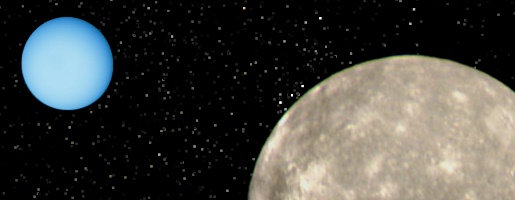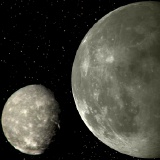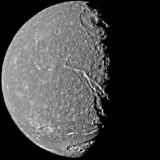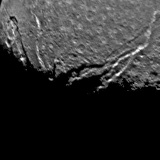 |
|
|
Montage
of Voyager images of Uranus and Titania.
|
|
| TITANIA - MOON OF URANUS | |
| Titania is the Queen of the Fairies and wife of Oberon in Shakespeare's play "A Midsummer-night's Dream". Titania was discovered in 1787 by the British astronomer Sir William Herschel who had discovered Uranus itself six years earlier. Voyager, so far from Titania in its flyby, was unable to provide images with a resolution better than about 13 kilometres per pixel. Only a third of the surface could be mapped. | |
| Orbit | |
| Titania orbits Uranus at a distance of 436,000 kilometres, in a nearly circular orbit (eccentricity 0.0022) and with a low inclination to Uranus' equatorial plane (0.14o ). It takes Titania 8.706 days to make one complete orbit of Uranus, the same time it takes Titania to rotate once on its own axis. Titania, therefore, exhibits synchronous rotation. | |
 The orbits of Uranus' larger moons. |
|
| Physical properties | |
| Titania, measuring 1580 kilometres across, is the largest of Uranus' moons, and the second most most massive. It is about the same size as Oberon. | |
 Comparison between Titania and our Moon. |
|
| Interior | |
| Like the other large moons, Titania has a fairly low density (1400 kg m-3) suggesting that it contains a large amount of water ice. It is probably about 50% ice, 50% rock. | |
| Titania looks very much like a larger version of Ariel and may have evolved in a similar way. Internal heat from the decay of radioactive materials and tidal heating early in Titania's history may have sustained a molten interior and enabled movement of the crust. The ragged faults, which appear to have been caused by expansion of the surface may have been generated in the same way as Ariel's chasmata. With a reduction in tidal heating and the expenditure of internal energy, the planet cooled and expanded. Extension formed great rifts in the surface. | |
| Atmosphere | |
| No atmosphere has been detected. | |
| Magnetic field | |
| No magnetic field has been detected. | |
| Surface | |
| Though Titania bears a resemblance to Ariel, it is much more heavily cratered. There is a greater size range and a variety of more complex forms. Craters with central peaks are common. There are also ring craters and large basins. The surface has recorded a prolonged cratering history, and is therefore very old. | |
 Voyager's highest resolution image of Titania, from 369,000 kilometres. |
|
| Titania, in common with Ariel, has a complex system of faults and fractures. These vary in character from those seen on Ariel. The largest canyon, Messina Chasmata (1500 kilometres) in Titania's southern hemisphere, has been broken along its length by surface movement since its formation. | |
 Titania's canyon system, Messina Chasmata. |
|
| The margins of Messina Chasmata are extremely rugged. Blocks of the original surface have sheared away from the back wall in several places. Where this has happened, a bright surface is revealed, clean ice underneath a dirty coating of rock and dust. A small amount of methane (CH4) may be present in the surface. | |
|
|
|